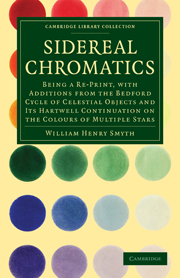 Sidereal Chromatics
Sidereal Chromatics Book contents
- Frontmatter
- TO JOHN LEE, ESQ., Q.C., LL.D., F.R.S., F.S.A., F.R.A.S., F.G.S., &c.
- Contents
- PART I A re-print, with additions, of the remarks on the Colours of Double Stars contained in the third chapter of the CYCLE OF CELESTIAL OBJECTS, under the title of “A Glance at the Sidereal Heavens.”
- PART II The Colours of Double Stars continued: being a re-print of the seventh chapter of the SPECULUM HARTWELLIANUM, with additions, and a proposed Diagram of Colours
- APPENDIX
- Postscript
- INDEX
PART II - The Colours of Double Stars continued: being a re-print of the seventh chapter of the SPECULUM HARTWELLIANUM, with additions, and a proposed Diagram of Colours
Published online by Cambridge University Press: 05 August 2011
- Frontmatter
- TO JOHN LEE, ESQ., Q.C., LL.D., F.R.S., F.S.A., F.R.A.S., F.G.S., &c.
- Contents
- PART I A re-print, with additions, of the remarks on the Colours of Double Stars contained in the third chapter of the CYCLE OF CELESTIAL OBJECTS, under the title of “A Glance at the Sidereal Heavens.”
- PART II The Colours of Double Stars continued: being a re-print of the seventh chapter of the SPECULUM HARTWELLIANUM, with additions, and a proposed Diagram of Colours
- APPENDIX
- Postscript
- INDEX
Summary
DOUBLE STAR COLOURS CONTINUED
Opening remarks
In consecution of this fascinating subject, we will now follow the period of 1844, the date of the “Cycle,” by that of 1860, the year in which the Hartwell Continuation appeared; after a further advertence to most of its matter, and considerable correspondence on the several points connected therewith. It has been suggested to me that some colours may undergo pulsations, but the adduced instances are mostly at low altitudes, where atmospheric influences are prevalent; and there may be a want of rigorous correction of the residual spectrum of the refracting telescope. But embarrassments in the outset of any enterprize only enhance the value of proven examples.
It may be noted—en passant—that a slight perturbation pervaded the minds of observing neophytes on the averment pronouncing that there are only three primary colours, namely— red, yellow, and blue; and that the other four—orange, green, indigo, and violet—are de facto produced by combinations of the former, and are therefore secondary or compound colours. This is, however, comparatively easy, as well to suggest as to adopt; but when an arrogant Goethe—unversed even in first principles—steps forward in the pride and panoply of popularity to explain the physiological and chemical qualities of the same, in order to demolish the “nauseous precepts of Newton,” we are really taken aback by his temerarious effrontery.
- Type
- Chapter
- Information
- Sidereal ChromaticsBeing a Re-Print, with Additions from the Bedford Cycle of Celestial Objects and its Hartwell Continuation on the Colours of Multiple Stars, pp. 22 - 74Publisher: Cambridge University PressPrint publication year: 2010First published in: 1864
